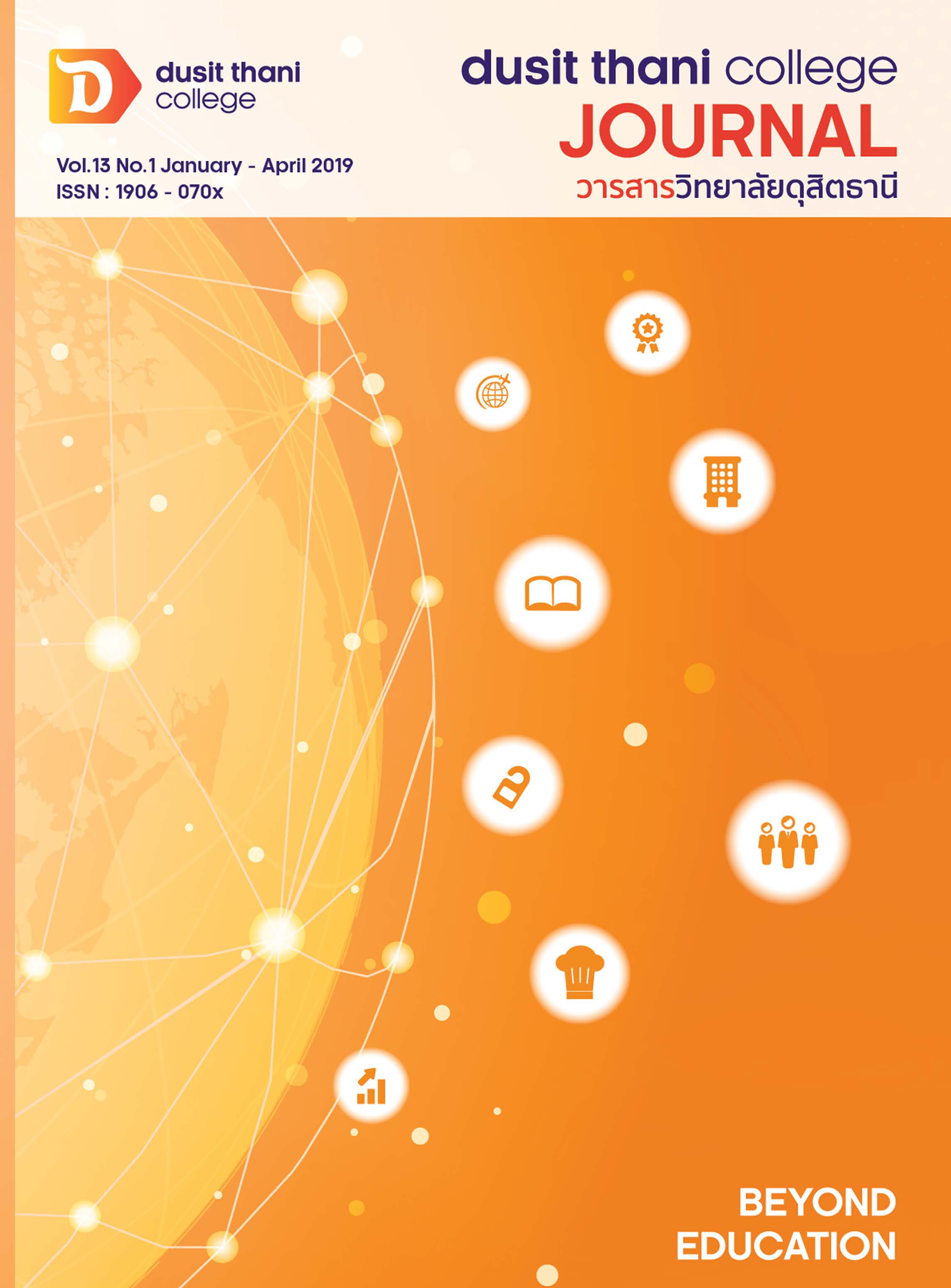Perspective of Thai Visually-impaired People Toward E-service Quality of Online Travel Booking Service
Main Article Content
Abstract
With the growing of online travel service, it seems to generate high benefit to visually-impaired tourists as they enable to access travel booking service just in front of their computers and not necessary to go to travel agents. The major purpose of this paper therefore was to study thePerspective of Thai Visually-impaired People toward E-service quality of Online Travel Booking service system by measuring five e-service quality factors include web design, reliability, privacy, responsiveness, and web customization. Data were collected from 189 thai visually-impaired people both total blindness and low-vision persons who ever used online travel service system at least once through survey method by e-mail sending. Findings were overall e-service quality of online travel booking service system was in fare level as the mean value equal to 2.99, however overall sample respondents viewed good level toward Reliability and responsiveness as the mean value were 3.54 and 3.46 respectively.
Article Details
Article Screening Policy
- All research and academic articles to be published must be considered and screened by three peer reviews in the relevant field / article.
- All articles, texts, illustrations and tables published in the journal are the personal opinions of the authors. Editors don't always have to agree. And no responsibility whatsoever is the sole responsibility of the author.
- The articles to be published must never be published. Where did you first publish? And not in the consideration of other journals If the audit found that there has been a duplicate publication It is the sole responsibility of the author.
- Any article that the reader sees as being plagiarized or impersonated without reference. Or mislead the work of the author Please let the journal editor know it will be your greatest blessing.
References
An exploratory field study with blind users. First Monday, 12(18).
2. BBC.(2013). Multimedia accessibility standards v1.0.http://www.bbc.co.uk/guidelines/futuremedia/accessibility/multimedia.shtml. [Retreived on December 28, 2017].
3. Bourne R. A., Flaxman S. R., Braithwaite T., Cicinelli M. V., Das A., and Jonas J. B. (2017).
Vision Loss Expert Group. Magnitude, temporal trends, and projections of the global prevalence of blindness and distance and near vision impairment: a systematic review and meta-analysis. Lancet Glob Health. 5(9):e888–97.
4. Buick, I. (2003). Information technology in small Scottish hotels: is it working?. International Journal of Contemporary Hospitality Management, 15(4). 243-247.
5. Carstens, D. S. and Patterson, P. (2005). Usability study of travel Web sites. Journal of Usability Studies, 1(1). 47–61.
6. Cyr, D. & Trevor-Smith, H. (2004). Localization of web design: An empirical comparison of German, Japanese, and US web site characteristics. Journal of the American Society for Information Science and Technology, 55(13), 1-10.
7. Damanpour, F. (2001). E-Business e-Commerce evolution: perspective and strategy. Managerial Financial, 27 (7), 16-33.
8. Hagg, S., Cummings, M., & Dawkins, J. (2000). Management information systems for the information age (2nd ed.). NY: McGraw-Hill.
9. Han J. H. and Mills, J. E. (2007). Are travel Web sites meeting the needs of the visually impaired?. Information Technology & Tourism 9(2). 99–113.
10. Kim, M., Kim, J. & Lennon, J. (2006). Online service attributes available on apparel websites: an E-S-QUAL approach. Managing Service Quality, 16(1), 51-77.
11. Lee, M.L. (2005). The impact of perceptions of interactivity on customer trust and transaction intention in mobile commerce. Journal of Electronic Commerce Research, 6(3), 165-180.
12. Li, H., and Suomi, R. (2007). Customer’s Perceptions and Intentions on Online Travel Service Delivery: An Empirical Study in China. Integration and Innovation Orient to E-Society, 2, 113.
13. Li, H., Liu, Y., and Suomi, R. (2009). Measurement of e-service quality: an empirical study on online travel service. Proceeding of 17th European Conference on Information Systems.
14. Lilly, E. (2001). Creating accessible Web sites: an introduction. The Electronic Library, 19(6), 397-405.
15. MaduCN, and Madu AA. (2002). Dimensions of e-quality. International Journal of Quality & Reliability Management, 19, 246-258.
16. Mills, J. E., Han, J. H. and Clay, J. M. (2008). Accessibility of hospitality and tourism Web sites:
A challenge for visually impaired persons. Cornell Hospitality Quarterly, 49(1), 28–41.
17. Morgan, N. J., Pritchard, A., and Abbott, S. (2001). Consumers, Travel and Technology: A Bright Future for the Web or Television Shopping?. Journal of Vacation Marketing 7(2), 110–124.
18. Parasuraman, A., Zeithaml, V.A. &Malhotra, A. (2005). E-S-QUAL: a multiple item scale for assessing electronic service quality. Journal of Service Research, 7(3), 213-233.
19. Parasuraman, A., Zeithaml, V.A. and Berry, L.L. (1988). SERVQUAL: A multiple-item scale for measuring consumer perceptions of service quality. Journal of Retailing, 64(1), 12-40.
20. Rust, R.T. and Kannan, P.K. (2002), “The era of e-service”, in Kannan, P.K. (Ed.), e-Service.New Directions in Theory and Practice, M.E. Sharpe, New York, NY.
21. Schreiber, C. (2016). Online travel booking outlook.http://www.statista.com
[Retreived on June 29, 2017].
22. Sentence, R. (2016). Which are the best and worst travel websites for accessibility?. https://www.clickz.com/which-are-the...travel-websites.../102764/ [Retreived on January 10, 2018].
23. Smith, A. C., Cook, J. S., Francioni, J. M., Hossain, A., Anwar, M. and Rahman, M. F. (2004). Nonvisual tool for navigating hierarchical structures. Assets ’04: Proceedings of the 6th International ACM SIGACCESS Conference on Computers and Accessibility, 133–139.
24. Sohn, C. and Tadisina, S.K. (2008). Development of e-service quality measure for the internet-based financial institutions. Total Quality Management & Business Excellence, 19(9), 903-918.
25. Van Riel, A.C.R., Lemmick, J., Streukens, S. &Liljander, V. (2004). Boost customer loyalty with online support: The case of mobile telecoms providers. International Journal of Internet Marketing and Advertising, 1(1), 4-23.
26. Vladimirov Z. (2012). Customer satisfaction with the Bulgarian tour operators and tour agencies' websites. Tourism Management Perspectives, 4, 176-184.
27. World Health Organization. (2017). ?Vision 2020. http://www.who.int/blindness/Vision2020_report.pdf [Retreived on January 15, 2018]
28. Wolfinbarger, M.F. &Gilly, M.C. (2003).EtailQ: Dimensionalzing, measuring and predicting detail quality. Journal of Retailing, 79(3), 183-198.
29. Zeithaml, V.A., Parasuraman, A. &Malhotra, A. (2002). Service quality delivery through websites: A critical review of extant knowledge. Journal of the Academy of Marketing Science, 30(4), 362-375.


